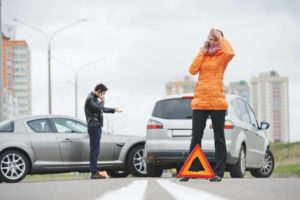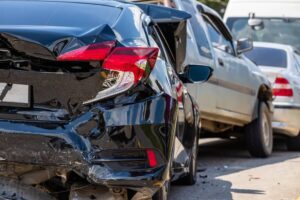
If your auto insurance company challenges your claim after a car accident, you may need to prove the other driver’s fault to recover full compensation. “No-fault” insurance in Florida will provide only up to $10,000 worth of personal injury protection (PIP) coverage for bodily injury and medical expenses and $10,000 for property damage. So, if you suffer severe injury in a crash and financial losses that go beyond those limits, you will need to prove the other driver was at fault.
Contents
- 1 Why Does Proving Fault Matter If Florida Is a No-Fault Insurance State?
- 2 What Information Helps to Determine Who Is At Fault for a Car Accident?
- 3 Can the Type of Car Accident Affect Who Might Be Considered to Be At Fault?
- 4 What Happens If I Am Partly Responsible for the Car Crash?
- 5 What Is Florida’s Statute of Limitations for a Car Accident Lawsuit?
- 6 How Can a Car Accident Lawyer Help Me with My Case?
- 7 Contact a Florida Car Accident Lawyer
Why Does Proving Fault Matter If Florida Is a No-Fault Insurance State?
Under “no-fault” auto insurance policies in Florida, an individual injured in a car accident initially relies on their PIP coverage to pay for medical expenses, a portion of their lost wages, and vehicle damage. Florida requires car owners to maintain a minimum of $10,000 worth of PIP coverage as well as a minimum of $10,000 in property damage liability (PDL) coverage. The PIP and PDL policies will provide coverage regardless of who was at fault in an auto accident.
If your losses exceed what PIP and PDL coverage provide, you will likely be able to file claims with the other driver’s insurance company if the driver caused the accident. However, when you do so, you must be ready to prove the driver’s fault.
What Information Helps to Determine Who Is At Fault for a Car Accident?
When you engage a personal injury lawyer to pursue your insurance claim after a car accident, the lawyer should immediately begin to gather evidence that will be necessary to prove the other driver’s negligence. This evidence typically includes:
- Police reports by the law enforcement officers who responded to the accident scene, gathered information from all drivers, and possibly issued citations for drunk driving or other traffic violations that led to the accident
- Identifying information about all parties involved in the accident, including drivers, passengers, and witnesses
- Details about the auto insurance policies of all other drivers in the crash
- Injuries to drivers and/or passengers and apparent vehicle damage.
- Eyewitness statements, including statements from you, the other driver(s), passengers, bystanders, drivers who stopped to offer help at the accident scene, and people who may have been in nearby homes or businesses who may have seen and/or heard the crash
- Photos and videos, including from nearby surveillance cameras, which may show the extent of vehicle damage (indicating vehicle speed and trajectory at impact), skid marks, and other debris on the road
- Accident location, including the road configuration, such as being an intersection, freeway ramp, or two-lane road with a low shoulder
- Conditions that may have contributed to the accident, such as inclement weather, heavy traffic, work zone conditions, or standing water
- Your injuries and condition immediately after the accident
- Cell phone records, which can show whether the other driver was texting or talking on the phone at the time of the crash, or whether they had been using the phone for a prolonged period, indicating fatigued driving
- Black box data, or information from the other car’s electronic data recorder (EDR), which can provide key details about the vehicle’s operations before the crash, including the car’s speed, whether the driver applied the brakes, the steering angle, and the exact date, time, and place of the collision.
It is critical to begin gathering evidence as soon as possible after a car accident before memories fade or physical evidence is degraded, destroyed, or lost.

Can the Type of Car Accident Affect Who Might Be Considered to Be At Fault?
Determining liability can be more complicated with some accidents than others. In a rear-end accident, for example, it’s not always the driver at the rear who’s at fault. Some accidents require extensive evidence to prove fault, such as those crashes that involve:
- Multi-vehicle pileups
- Accidents due to road or vehicle defects
- Secondary car accidents (which occur as the result of another crash)
- Crashes in which several drivers have some degree of fault.
In some cases, an attorney may retain the services of accident reconstruction professionals to determine the cause of the accident and identify who should be held accountable. Accident reconstruction can explain the circumstances, mechanics, and contributing factors associated with a crash, as well as the injuries suffered in a car accident. Accident reconstruction is based on principles of physics, engineering, and mathematics. It also involves analyzing information from the crashed vehicles, police reports, cell phones, photos, videos, and other evidence.
An accident reconstruction professional develops a detailed, moment-by-moment depiction of a motor vehicle accident and various scenarios to explain why the accident may have occurred. Typically, they will submit a written report. If a car accident insurance claim proceeds to court as a personal injury lawsuit, the accident reconstruction professional may be called to testify as an expert witness. Accident reconstruction presentations typically feature digital animation and detailed explanations of car accidents, which can make a strong impact on juries.
An accident reconstruction professional can promptly visit the crash scene and use electronic surveying equipment to produce a computer-generated scale diagram of what occurred. Your attorney can also seek to have the vehicles involved in the accident preserved for examination by seeking a court order.
What Happens If I Am Partly Responsible for the Car Crash?
You may still recover compensation in a car accident claim if you were partially at fault. However, the amount will be reduced according to the extent of your fault.
In personal injury lawsuits, Florida applies the doctrine of comparative negligence, not comparative fault. When multiple negligent parties are involved in a crash, any compensation awarded must be apportioned according to each party’s share of fault.
If the parties in a personal injury lawsuit share blame for the car accident, a percentage of fault must be assigned to each party based on the evidence. For example, another driver could run a stoplight and slam into your vehicle. However, you may have been speeding at the time. If you were 35 percent at fault for the crash due to your speeding, your compensation would be reduced by 35 percent.
If you are found to be greater than 50 percent at fault for an accident, you cannot be eligible to receive compensation.
What Is Florida’s Statute of Limitations for a Car Accident Lawsuit?
Florida’s statute of limitations allows an injured person two years from the date of their injury to file a lawsuit based on the at-fault party’s negligence. The statute of limitations for wrongful death claims is two years from the date of death.
Because of the strict deadlines for a car accident lawsuit, you should contact an attorney as soon as possible if you think someone else’s negligence led to your injuries in a car crash. The investigation and other work required before you file a lawsuit require time. Additionally, an insurance company may use delay tactics to potentially disrupt your claim. Your attorney can evaluate your claim and take prompt legal action to protect your rights.
How Can a Car Accident Lawyer Help Me with My Case?
If you have suffered significant injuries in a car accident, our team at Zervos & Calta, PLLC, can help you determine your legal options and guide you through the next steps for seeking compensation. While you focus on recovering from your injuries in the weeks and months following a car accident, we will:
- Investigate your car accident — We will collect all available evidence to determine who should be held accountable for the accident, as well as track and document your medical expenses, other costs, and losses to ensure we are seeking full compensation for you.
- Fully litigate your claim — We will protect your rights and pursue the maximum compensation you are due, including damages that fully cover your financial losses and compensate you for your pain, suffering, and emotional distress. We are aggressive negotiators and can settle most car accident claims outside of court. However, we will be prepared to take a solid case to court for you, if necessary.
- Fight for you — Our experienced team knows how to battle insurance companies and pursue the compensation our clients deserve. Don’t settle for less. Let us make things right for you.
Contact a Florida Car Accident Lawyer
An experienced Tampa Bay Area car accident lawyer from Zervos & Calta, PLLC, will fight for the compensation you deserve after a negligent driver has caused you to suffer serious injuries in a crash. We can put more than 50 years of combined legal experience in your corner and our tough-as-nails reputation for holding negligent drivers accountable. To learn more, contact us today and receive a free consultation. We won’t charge you a legal fee unless we recover money on your behalf. We are here to pursue results for you.


